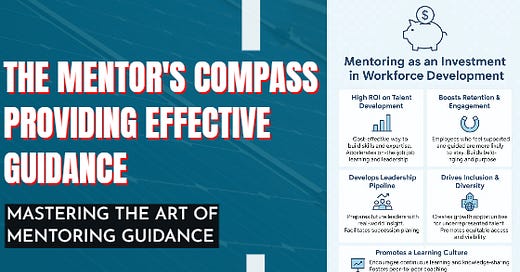The Mentor's Compass: Providing Effective Guidance
Mastering the Art of Mentoring Guidance
We have heard a lot about mentoring, at work. Some or many of us have already been mentoring team members and some others are curious to know what it entails, its benefits, and how they could become effective mentors.
What is Mentoring?
Mentoring is a powerful tool for personal and professional growth, benefiting both the mentor and the mentee. It involves sharing knowledge, experience, and guidance to help someone navigate challenges, develop skills, and achieve their goals.
Here are some key aspects of mentoring:
1. Types of Mentoring
Formal Mentoring: Structured programs within organizations or educational institutions.
Informal Mentoring: Unstructured, natural relationships formed over time.
Reverse Mentoring: Younger or less experienced individuals mentor senior professionals, often in areas like technology or social trends.
Peer Mentoring: Colleagues or individuals at similar levels support each other.
Group Mentoring: A mentor guides multiple mentees at once.
2. Roles & Responsibilities
Mentor:
Share knowledge and experiences.
Provide encouragement and constructive feedback.
Help set goals and track progress.
Offer networking opportunities.
Mentee:
Be proactive in seeking guidance.
Ask thoughtful questions and apply feedback.
Take ownership of personal and professional growth.
Show appreciation and respect for the mentor’s time.
3. Benefits of Mentoring
For Mentors:
✅ Personal fulfillment from helping others grow.
✅ Improved leadership and coaching skills.
✅ Exposure to new ideas and fresh perspectives.
✅ Expanded professional network.
For Mentees:
✅ Faster career and personal development.
✅ Avoiding common mistakes by learning from experience.
✅ Increased confidence and motivation.
✅ Access to new opportunities.
4. How to Be an Effective Mentor
Build trust and open communication.
Be a good listener—understand the mentee’s goals.
Provide honest and constructive feedback.
Share real-life experiences, not just theoretical advice.
Encourage independence and critical thinking.
5. How to Find a Mentor or Mentee
Within your organization (mentorship programs, leadership teams).
Networking events & conferences.
Online platforms (LinkedIn, industry-specific forums).
Professional associations & alumni networks.
Let’s look at Goal Setting and Career Development
Goal setting and career development are key aspects of mentoring, both for mentors guiding others and for individuals looking to advance in their careers. Let’s break it down:
📣 Goal Setting: Laying the Foundation for Growth
Setting clear and achievable goals helps create a roadmap for success. Goals should be SMART:
🔹 SMART Goals Framework
✅ Specific – Clearly define what you want to achieve.
✅ Measurable – Set criteria to track progress.
✅ Achievable – Ensure it is realistic given resources and time.
✅ Relevant – Align with your long-term aspirations.
✅ Time-bound – Set deadlines for motivation.
Example: Instead of saying “I want to improve my leadership skills,” a SMART goal would be “I will complete a leadership training course within the next six months and apply those skills by leading a team project.”
📣 Career Development: A Strategic Approach
Career development is a continuous process involving skill-building, networking, and strategic decisions.
🔹 Key Steps for Career Development
1️⃣ Self-Assessment – Identify strengths, weaknesses, interests, and values.
2️⃣ Skill Development – Learn new skills (technical & soft skills) based on career aspirations.
3️⃣ Networking – Build relationships with mentors, peers, and industry professionals.
4️⃣ Seeking Feedback – Regular feedback from mentors and supervisors accelerates growth.
5️⃣ Adapting to Change – Be open to learning and evolving with industry trends.
🔹 Career Growth Strategies:
Take on stretch assignments to challenge yourself.
Join professional associations related to your field.
Find mentors and sponsors who can advocate for your growth.
Keep an achievement journal to track progress and prepare for promotions.
📣 Aligning Mentoring with Career Development
Mentors play a crucial role in career growth by:
✔ Helping set realistic and strategic career goals.
✔ Offering industry insights and guidance.
✔ Encouraging skill-building and continuous learning.
✔ Assisting with networking and career advancement opportunities.
Mentees, on the other hand, should:
✔ Be proactive in seeking advice and feedback.
✔ Act on the guidance received and take ownership of progress.
✔ Maintain regular communication with mentors.
Now let’s look at another important aspect - Skill Development through Mentoring
Mentoring is a powerful way to develop skills, whether you're a mentor helping others grow or a mentee looking to enhance your abilities. It provides personalized learning, real-world insights, and accountability—making skill development more effective than traditional learning methods.
1. Key Skills That Can Be Developed Through Mentoring
Mentoring can help develop a wide range of hard skills (technical knowledge) and soft skills (interpersonal abilities).
🔹 Soft Skills (Critical for career growth)
✔ Communication: Improve clarity, articulation, and active listening.
✔ Leadership: Learn decision-making, delegation, and team management.
✔ Problem-Solving: Develop critical thinking and analytical abilities.
✔ Time Management: Prioritize tasks and balance responsibilities.
✔ Emotional Intelligence: Enhance self-awareness, empathy, and relationship management.
✔ Networking & Relationship Building: Learn how to create meaningful professional connections.
🔹 Hard Skills (Industry-specific and technical skills)
✔ Technical Expertise: Gain hands-on knowledge in a specific domain.
✔ Project Management: Learn to plan, execute, and lead projects efficiently.
✔ Data Analysis & Decision-Making: Improve data-driven decision-making skills.
✔ Digital Literacy & Tools: Learn industry-relevant software and digital tools.
2. How Mentoring Enhances Skill Development
🔹 Structured Learning & Real-World Application
Mentors share practical experiences beyond theoretical knowledge.
Mentees apply skills in real-world scenarios, gaining hands-on experience.
🔹 Feedback & Continuous Improvement
Regular feedback helps identify strengths and areas for improvement.
Mentors guide mentees through trial and error, accelerating growth.
🔹 Networking & Exposure
Mentees gain insights into industry trends and best practices.
Mentors introduce mentees to professional networks and opportunities.
🔹 Personalized Growth Plan
Mentors tailor development plans based on the mentee’s goals.
The learning journey is adaptive and focused, leading to faster growth.
3. Implementing Skill Development in Mentoring
🔹 For Mentors
✔ Assess the mentee’s current skill level and goals.
✔ Provide learning resources (books, courses, case studies).
✔ Offer real-world challenges and guide them through solutions.
✔ Give constructive feedback and track progress.
✔ Encourage self-reflection and independent problem-solving.
🔹 For Mentees
✔ Set clear learning objectives at the start of mentorship.
✔ Be proactive—ask questions, seek feedback, and take initiative.
✔ Apply lessons in real projects and day-to-day tasks.
✔ Track progress and reflect on key learnings and improvements.
4. Practical Examples of Skill Development Through Mentoring
📌 Scenario 1: Enhancing Leadership Skills
A mentee struggling with team management learns from a mentor’s experience. The mentor assigns small leadership tasks, provides feedback, and gradually increases responsibility.
📌 Scenario 2: Improving Public Speaking
A mentor coaches a mentee on structuring speeches, practicing in smaller groups, and eventually presenting to larger audiences with confidence.
📌 Scenario 3: Learning a New Technology
A mentor in data science helps a mentee build hands-on projects, review code, and refine technical skills through real-world applications.
Is mentoring part of mainstream activities in corporate companies?
Mentoring has become a mainstream and strategic activity in many corporate environments—especially those that prioritize employee development, retention, and leadership growth. While the format and emphasis may vary by organization, here’s how mentoring plays a mainstream role:
🔹 Why Corporates Embrace Mentoring
✅ Talent Development & Retention
Mentoring helps upskill employees, improve job satisfaction, and build loyalty.
Companies with mentoring programs often see higher retention rates, especially among new hires and high-potential talent.
✅ Leadership Pipeline
Mentoring grooms future leaders by transferring knowledge and leadership skills from experienced professionals to rising stars.
Succession planning becomes smoother with mentoring as a tool for leadership readiness.
✅ Knowledge Transfer
It facilitates the sharing of institutional knowledge, best practices, and company culture—especially during mergers, acquisitions, or retirements.
✅ Diversity, Equity & Inclusion (DEI)
Structured mentoring supports underrepresented groups, creating more inclusive leadership pipelines and reducing barriers to advancement.
🔹 Common Types of Corporate Mentoring Programs
Onboarding Mentoring:
To help new employees integrate faster and feel supported.Peer Mentoring:
Between colleagues at similar levels for knowledge-sharing and support.Reverse Mentoring:
Junior employees mentor senior leaders on emerging trends like tech, digital tools, or generational insights.Leadership/Executive Mentoring:
Senior leaders mentor mid-level managers to build strategic thinking and executive presence.Group or Circle Mentoring:
One mentor with multiple mentees—fosters collaboration and diverse perspectives.
🔹 How It’s Managed
Many companies use formal platforms or software (e.g., Chronus, MentorcliQ, Together) to match mentors and mentees.
HR and L&D departments often include mentoring as part of employee development frameworks or performance management cycles.
Some organizations integrate mentoring into corporate social responsibility or alumni engagement programs.
Here are some real-world examples given in the chart below:
How do you balance your time being a mentor and also get your work done?
🕒 1. Set Clear Boundaries & Expectations
Define time commitments upfront—e.g., one session every 2 weeks for 45 minutes.
Agree on goals early with your mentee so meetings are focused and actionable.
📅 2. Block Time on Your Calendar
Treat mentoring sessions like important meetings—schedule them.
Avoid ad hoc chats unless urgent; having structure helps maintain balance.
🎯 3. Make It Goal-Oriented
Each session should have a clear agenda—this saves time and ensures value.
Use shared documents or a mentoring journal to track progress between meetings.
🤝 4. Integrate Mentoring into Your Day
Turn some mentoring into “walk and talk” meetings or brief check-ins.
Use real work scenarios to teach, e.g., invite mentees to observe or collaborate on live projects.
🛠️ 5. Use the Right Tools
Use templates for feedback, career development plans, or skill checklists.
Asynchronous tools (email, Slack, shared notes) can keep things moving without needing real-time syncs.
🔁 6. Evaluate & Adjust
Every few months, do a pulse check: Are you both getting value? Is the cadence right?
If needed, scale back to “light touch” mentoring or group sessions temporarily.
✨ Pro Tip:
Great mentors also grow through mentoring—by sharpening leadership, communication, and coaching skills. So it’s not a time drain, it’s an investment in yourself too.
References:
Why Mentorship Reinforces Employee Learning and Training
Ryan Carruthers, Together, Jan 26, 2022
The Hidden ROI of Workplace Mentoring
Abel Personnel, Feb 27, 2024





